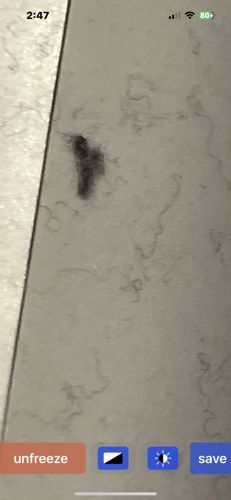Carpet Beetle (larvae)
Scientific Name: Dermestes lardarius (Larderr Beetle) or various species within the Dermestidae family, such as Anthrenus verbasci (Varied Carpet Beetle), Trogoderma variabile (Warehouse Beetle). The image most closely resembles a carpet beetle larva.
Order & Family: Order: Coleoptera, Family: Dermestidae
Size: Larvae typically range from 1 to 5 mm (0.04 to 0.2 inches) in length, depending on the species and developmental stage. They are often hairy or bristly.

Natural Habitat
Indoors, carpet beetle larvae are commonly found in carpets, rugs, upholstered furniture, closets, attics, and around baseboards where lint, pet hair, and other debris accumulate. Outdoors, adults are found on flowers.
Diet & Feeding
The larvae feed on a wide variety of animal products, including wool, silk, feathers, leather, fur, pet hair, dead insects, and dried meat. They can also feed on plant-based materials like grains and cereals. Adult carpet beetles feed on pollen and nectar.
Behavior Patterns
Carpet beetle larvae primarily feed on organic materials, particularly in dark, undisturbed areas. They are known for their slow movement and often curl up when disturbed. Adults are attracted to light and are often found near windows.
Risks & Benefits
Risks: Carpet beetle larvae can cause significant damage to household items made of natural fibers, such as clothing, carpets, and upholstered furniture. They do not bite or transmit diseases to humans. Benefits: As decomposers, they play a small role in breaking down organic matter in nature.
Identified on: 9/2/2025